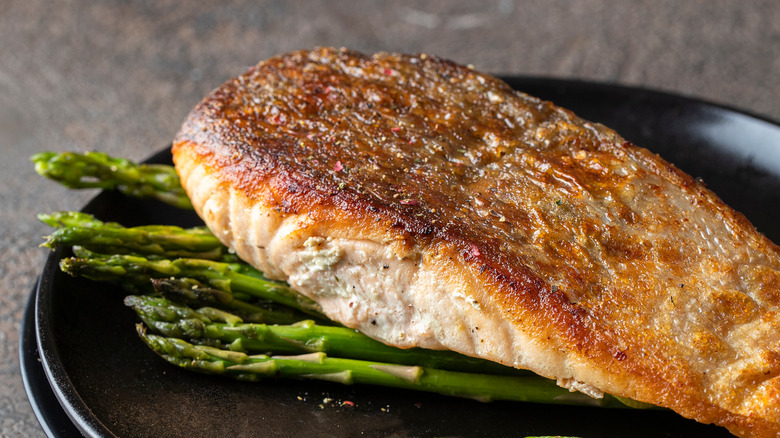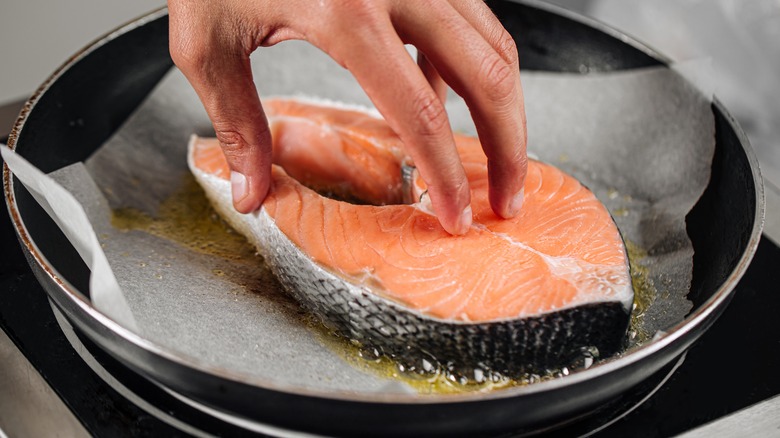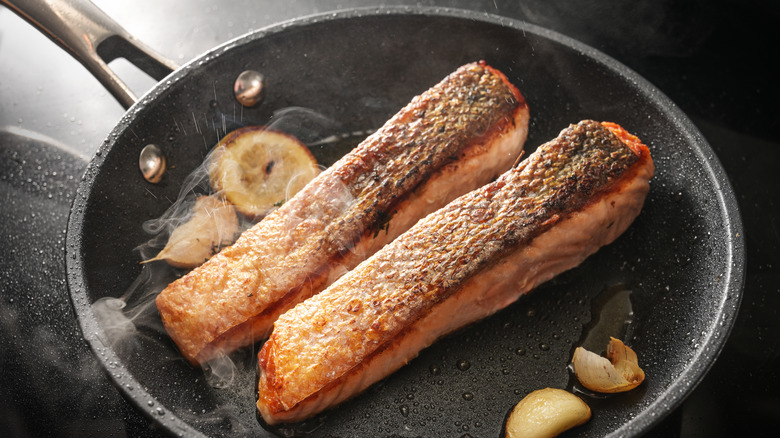The Parchment Paper Hack For Shatteringly Crisp Salmon Skin
A well-cooked piece of salmon is a beautiful thing. The contrast in textures is one of the factors that makes it so special, with soft, tender flesh and a crisp, salty layer of skin. Getting that combination just right in your own kitchen isn't always easy, though, so it's not surprising that fish can be a daunting dish to prepare for many home cooks.
Salmon is best cooked with its skin on, even if you prefer to serve it skinless, as it helps protect the fish so it cooks more evenly with less chance of being overdone. Let's assume you do want to serve it skin-on, as it's incredibly tasty, as well as providing a great crunchy texture. But just getting the skin of a piece of salmon crisp, without the fish sticking, can prove tricky. It's prone to tearing, leaving bits stuck in the pan, which means a lot of mess to clean up as well as a less appetizing end result. But help is at hand, thanks to a common piece of kitchen kit: parchment paper.
Heat-resistant to temperatures of around 420 degrees Fahrenheit, parchment paper makes an ideal hack for cooking a piece of salmon on the stove, and the fact that it's non-stick means the fish skin won't stick or rip. Plus it can be cut to fit any size of pan, meaning you don't need to buy any additional equipment for the best possible results.
Parchment paper gives crispy salmon skin with no sticking
If you're worried about salmon sticking to your pan when cooking, then you might be tempted to use a non-stick pan to minimize the risk. It seems like an obvious solution. But this isn't the best option for cooking fish if you want a crisp skin. Non-stick pans are not ideal for searing proteins such as salmon because they don't allow fat to spread evenly across the food; you can see this in the beads of fat created when cooking in a non-stick pan.
Stainless steel or cast iron is a much better option for crisping food — though it does mean that food can stick. And delicate salmon is notorious for sticking to metal pans. But with its thin silicone coating, non-stick parchment paper allows you to use your favorite pan to cook salmon, for a crispy result without the skin either sticking, ripping, or coming away from the flesh completely.
The hack is simple, involving cutting a piece of parchment that's bigger than the piece of fish and laying it flat over just a little oil in a hot pan on the stove. Drizzle a little more oil on top of the paper, and cook the salmon skin-side down until almost done, before flipping it to finish. As a bonus, cooking it gently and skin-side down is a great way to cook salmon so that it doesn't leak white goo, too.
Other hacks for getting crispier seared salmon skin
Parchment paper's non-stick qualities have been praised by top chefs when it comes to cooking fish for years, with Michelin-starred Alain Ducasse recommending its use back in 2002 (via The New York Times.) And cooking en papillote (meaning in parchment) is a classic French technique of cooking fish inside a parchment parcel for tender, semi-steamed flesh. But when it comes to pan-seared salmon, there are also several other things you can do — in addition to the parchment paper hack — to guarantee crispy skin every time.
Drier fish skin will crisp and brown better than wet, so dry the salmon with paper towels before you start cooking. Even better, leave it uncovered, skin-side up in the refrigerator to dry – an hour in the fridge takes salmon to restaurant status. Press the salmon with a spatula once it's skin-side down on the parchment paper in the pan. Holding it down for between 10 and 30 seconds will stop the ends from curling, and help it crisp evenly.
Finally, cook the fish mostly skin-side down, before turning it once it's almost cooked. This is a similar method to unilateral cooking, a term meaning the food is cooked on only one side, with a flip just to quickly finish the other side before serving. And in just a few steps, and with a little help from a square of parchment, the crispiest skinned salmon will be yours.



